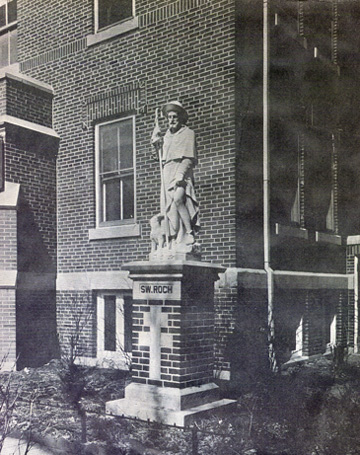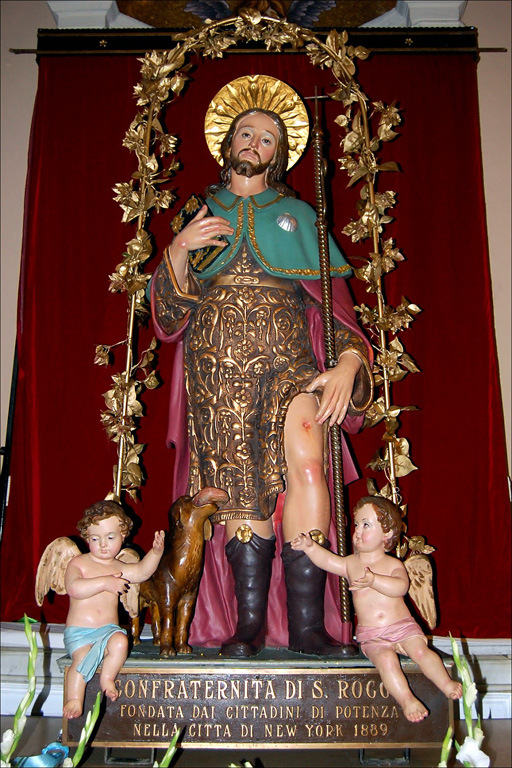Miracle of St. Rocco
Standing watch over the Warszawa neighborhood of St. Stanislaus Church is a memorial to a pandemic of another century, one possibly more deadly than the one we are now experiencing. That H1N1 viral strain infected a third of Earth's population at the time and may have killed upwards of 50 million people.
 Today,
as then, we latch on to medical hopes of treatments and cures. The
faithful of St. Stanislaus Church in 1918 instead hopefully prayed to
St. Rocco, patron saint of those affliced with contagious disease.
Today,
as then, we latch on to medical hopes of treatments and cures. The
faithful of St. Stanislaus Church in 1918 instead hopefully prayed to
St. Rocco, patron saint of those affliced with contagious disease.
Born in 14th century France with a cross-shaped birthmark on his left chest, the orphaned Rocco was cared for by his uncle, the Duke of Montpelier.
From his youth Rocco exhibited great devotion to God and the Blessed Mother. He distributed his wealth to the poor and took a vow of poverty, dressed as a pilgrim and departed for Rome.
Italy was ravaged by a rampant plague at the time of his arrival. Saint Rocco cured many simply with prayer and the Sign of the Cross. He too contracted the same disease, manifesting inself with an open sore on his leg. Banished from the city, he took refuge in a cave, sleaping on leaves and drinking water from a nearby stream. Miraculously, a dog that had been refusing to eat, faithfully brought him bread daily as sustenance. The dog would leave a nearby castle, and the lord of the castle, having a curious nature, followed him one day. Discovering Rocco, the nobleman pitied him and nursed him at his castle until he recovered.
Travelling through northern Italy for a few more years, Rocco returned to his birthplace, a sick and weakened man no one recognized. With no evidence to the contrary, Rocco suffered imprisonment for five years as a spy. During the day of August 16th, 1378, a guard found Rocco near death and his cell illuminated with a blue light radiating from his body. Informing the Governor, the Duke of Montpelier, the Duke demanded of Rocco his identity. Rocco faintly replied that he was his nephew. Wanting proof of the identity, the Duke had Rocco disrobed, revealing the cross-like mark on his left chest. With this revelation all present then believed!
 Even
after his death Saint Rocco performed many miracles, one of them being
attributed to him right here in Slavic Village. With the Spanish Flu
epidemic raging in 1918 Cleveland, the immigrant European Poles of St..Stanislaus
would surely have known of his powers and therefore prayed to Saint Rocco for deliverance from that
plague. In thanksgiving for his intercession, they erected the statue in
his honor. It has stood in the front yard of the parish house for
102 years as a reminder to the neighborhood that through their prayers
to Saint Rocco no parishioners' lives were lost in the epidemic..
Even
after his death Saint Rocco performed many miracles, one of them being
attributed to him right here in Slavic Village. With the Spanish Flu
epidemic raging in 1918 Cleveland, the immigrant European Poles of St..Stanislaus
would surely have known of his powers and therefore prayed to Saint Rocco for deliverance from that
plague. In thanksgiving for his intercession, they erected the statue in
his honor. It has stood in the front yard of the parish house for
102 years as a reminder to the neighborhood that through their prayers
to Saint Rocco no parishioners' lives were lost in the epidemic..
Saint Rocco is venerated in the Catholic Church as the protector against all contagious diseases. His statue is considered unique among theologians because of its pose. It is most unusual because it depicts him with his left hand pointing to an open sore on his left leg. Few saintly images expose any afflictions or handicaps. He is also depicted with a pilgrim's staff and a dog at his side bringing him bread.
Saint Rocco's body is enclosed in a glass tomb in the Church of Saint Rocco in Venice, Italy. His death is commemorated on August 16th each year.
Visit the link to the Saint Rocco website here.